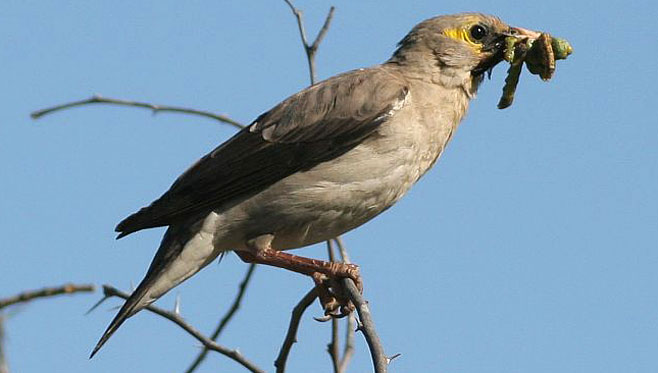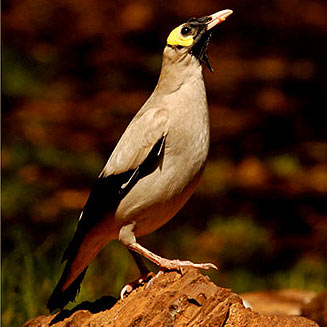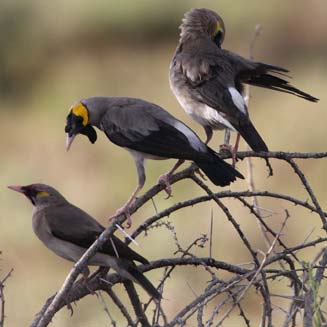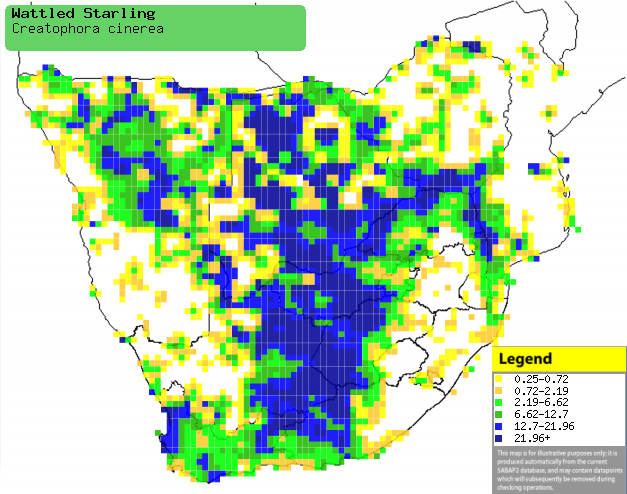|
Creatophora cinerea (Wattled starling)
Lelspreeu [Afrikaans]; Unowambu, Uwambu [Xhosa];
iMpofazana [Zulu]; Leholi (generic term for starlings) [South Sotho]; Kwezu
elimhlope [Tsonga]; Lelspreeuw [Dutch]; Étourneau caronculé [French];
Lappenstar [German]; Estorninho-carunculado [Portuguese]
Life
> Eukaryotes >
Opisthokonta
> Metazoa (animals) >
Bilateria >
Deuterostomia > Chordata >
Craniata > Vertebrata (vertebrates) > Gnathostomata (jawed
vertebrates) > Teleostomi (teleost fish) > Osteichthyes (bony fish) > Class:
Sarcopterygii (lobe-finned
fish) > Stegocephalia (terrestrial
vertebrates) > Tetrapoda
(four-legged vertebrates) > Reptiliomorpha > Amniota >
Reptilia (reptiles) >
Romeriida > Diapsida > Archosauromorpha > Archosauria >
Dinosauria
(dinosaurs) > Saurischia > Theropoda (bipedal predatory dinosaurs) >
Coelurosauria > Maniraptora > Aves
(birds) >
Order: Passeriformes > Family: Sturnidae
 |
|
Wattled starling in non-breeding plumage,
Niewoudtville, South Africa. [photo Trevor Hardaker ©] |
 |
 |
|
Wattled starling. [photo Callie de Wet ©] |
Wattled starlings, just south of Kimberley,
Northern Cape, South Africa. [photo Andries Steenkamp
©] |
Distribution and habitat
Occurs from Ethiopia and Kenya through Tanzania, southern
DRC and Zambia to southern Africa. Here it is locally common across much of the
region, generally preferring sparse woodland and other open habitats, such as
grassland and cultivated areas.
|
 |
|
Distribution of Wattled starling in southern Africa,
based on statistical smoothing of the records from first SA Bird Atlas
Project (©
Animal Demography unit, University of
Cape Town; smoothing by Birgit Erni and Francesca Little). Colours range
from dark blue (most common) through to yellow (least common).
See here for the latest distribution
from the SABAP2. |
Predators and parasites
Flightless young have been recorded as prey of the
following birds:
Movements and migrations
It is nomadic, moving around in response to
insect abundance in different areas.
Food
It mainly eats insects, fruit, seeds and nectar, doing most
of its foraging on the ground, plucking prey from the surface or proving the
ground to catch burrowing arthropods. It may occasionally forage in the
intertidal zone, and it often follows game and livestock, removing ectoparasites
from their skin. The following food items have been recorded in its diet:
- Invertebrates
- Plants
- nectar
- Erythrina caffra (Coast coral-tree)
- Schotia brachypetala (Weeping boer-bean)
- Acrocarpus fraxinifolius (Pink cedar)
- seeds
- Pollichia campestris (Waxberry)
- maize
- fruit
- Ziziphus mucronata (Buffalo-thorn)
- Azima tetracantha (Needle-bush)
- grapes
- Ficus (figs)
Breeding
- Monogamous and highly colonial, nesting in colonies within which laying
dates and other breeding activities are completely synchronised.
- The nest is a bulky, domed structure within an entrance on the side or
near the top, built of sticks and lined with grass and feathers. It is
typically placed in a tree (especially Acacia) conjoined to other
nests in the colony, forming one large interlocking mass.
- Egg-laying season peaks from September-December in the Western Cape,
later in summer rainfall areas, from January-March.
- It lays 2-5 eggs, which are incubated by both sexes for about 11 days.
- The chicks are fed by both parents on a diet of mainly insects, leaving
the nest after about 13-16 days, before they can fly.
Threats
Not threatened.
References
-
Hockey PAR, Dean WRJ and Ryan PG 2005. Roberts
- Birds of southern Africa, VIIth ed. The Trustees of the John Voelcker
Bird Book Fund, Cape Town.
|
